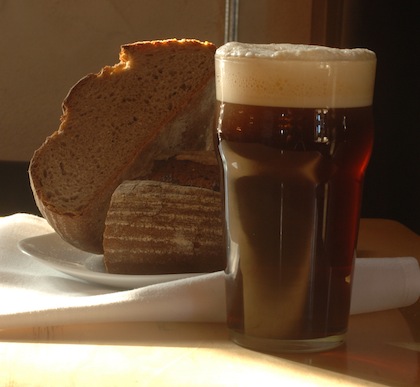Nature has a way of taking care of our needs and balancing things out. Take grains. Certain grains, such as barley for instance, are great for making beer. Others, such as corn, are better suited for breakfast cereal. Rye makes great whiskey, while rice makes excellent sushi. And wheat makes delicious bread.
In a sense, brewers are rediscovering what Bourbon distillers have long recognized.
But brewers have long been unwilling to be limited to just barley malt. One of the exceptions the Germans make to the Reinheitsgebot is for wheat. Some brewers use corn and rice as adjuncts, while the latest wave of grain in vogue with American brewers is rye.

(Kinsley Dey)
I like the texture and complexity of the malt profile that the rye contributes,” says Taylor Rees, head brewer at Great Divide Brewing in Denver, CO. Great Divide Hoss is a rye lager that was first brewed as a fall seasonal two years ago, but now is available throughout the year.
In a sense, brewers are rediscovering what Bourbon distillers have long recognized. Bourbon must be at least 51 percent and no more than 79 percent corn whiskey. Distillers add a combination of whiskey made from barley and rye to the blend, with some also adding some wheat whiskey. Changing the level of rye in the blend has the most direct influence on flavor and mouthfeel of the Bourbon. Shifting consumer palates has resulted in the reemergence of rye whiskey as a category, with most companies now offering a rye version of their leading Bourbon labels.
Rye is a great ingredient for flavor,” says Spike Buckowski, brewmaster at Terrapin Beer Co. in Athens, GA. “Some people over do it a bit. We use rye for the nuance of the flavor.”
Rye helped put Terrapin on the beer map. Buckowski had been homebrewing with rye since 1993. When the brewery made its first beer in 2002, contract brewed at Dogwood Brewing in Atlanta, it was Terrapin Rye Pale Ale. The recipe calls for 10 percent rye in the grist. Six months after making the beer commercially for the first time, it earned a gold medal at the Great American Beer Festival.
People wondered why we wanted to start out with a big, imposing pale ale,” Buckowski says. “The rye actually dries the palate out and pulls the bitterness forward. You have to remember that for a long time in the Southeast if you brewed anything hoppier than a Budweiser people would freak out.”











I remember well when Terrapin Rye Pale Ale took the area by storm. Terrapin Ale has what I call “lock in”, the dryness makes ordering another Terrapin draft mandatory – anything else would taste, well, lame. Great Divide Hoss has the same trait, especially on draft. The Terrapin and GD rye brews show just how great the addition of rye can be, and the popularity of these brews bear out this fact.